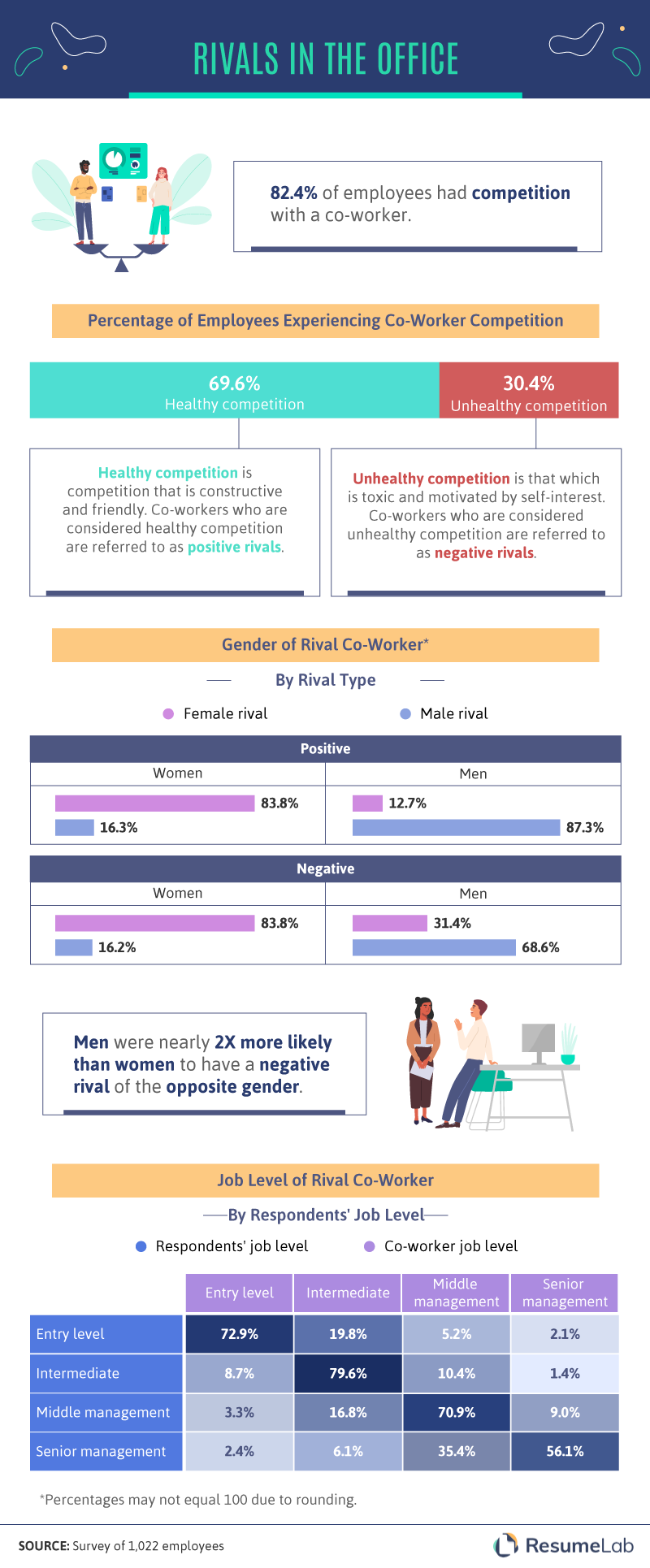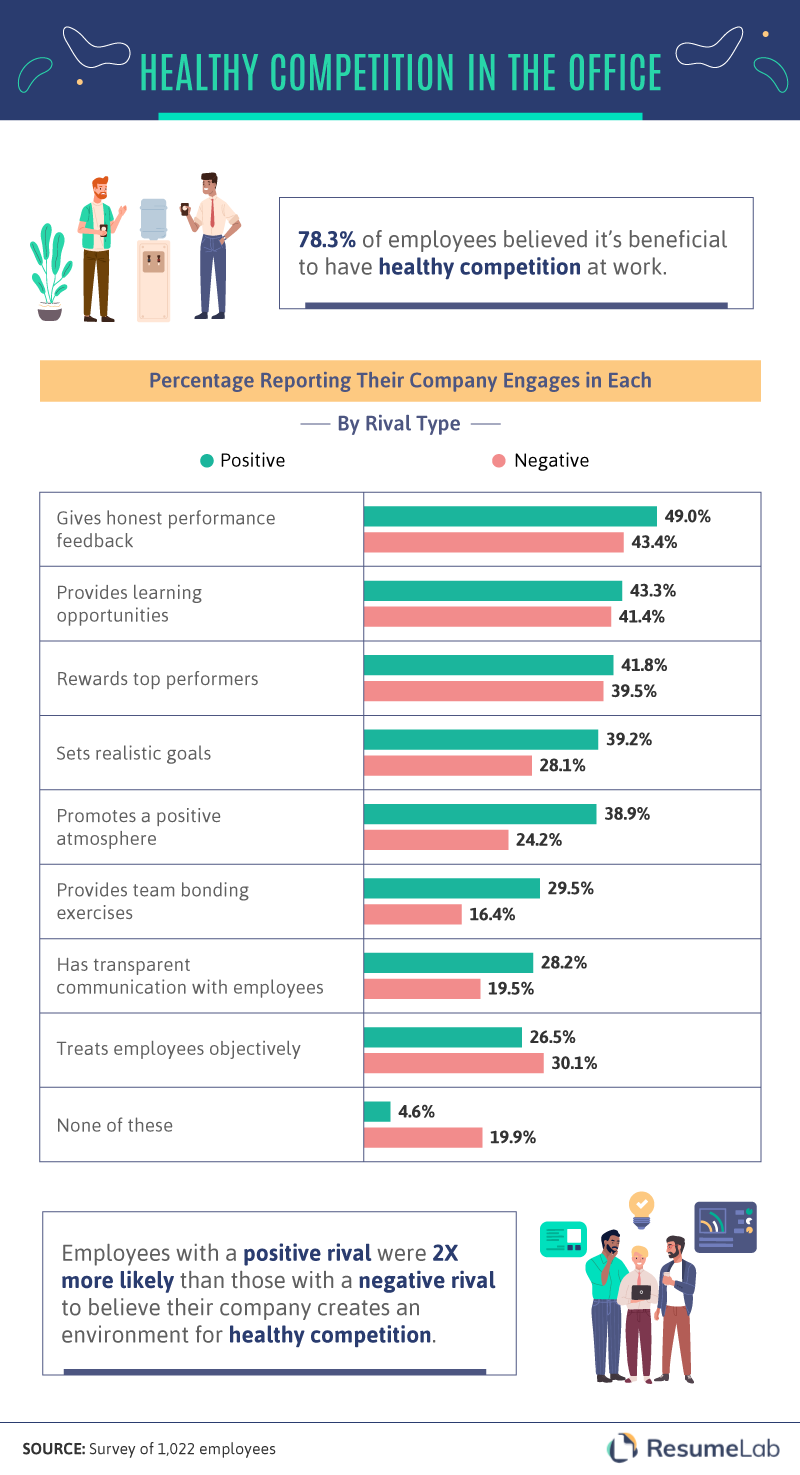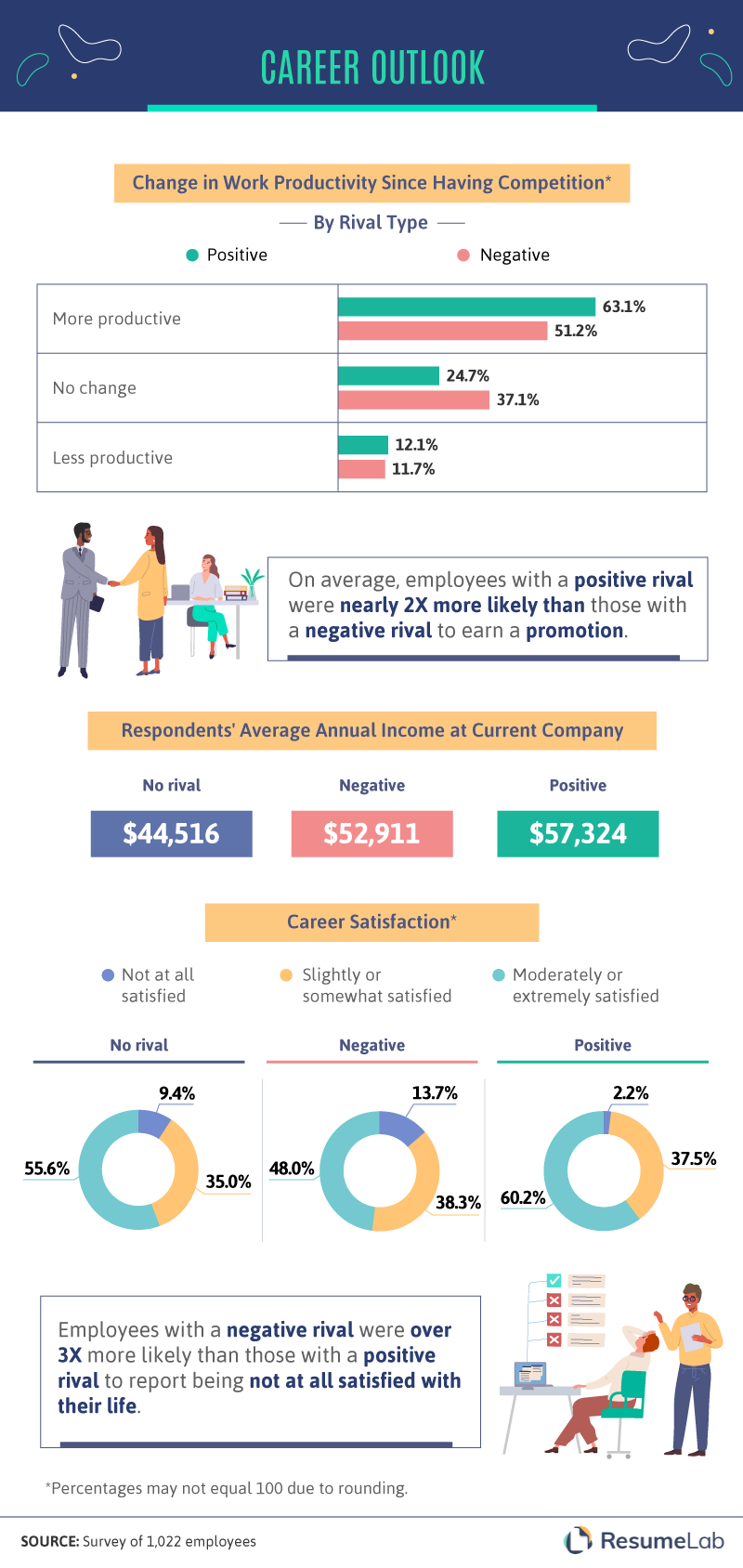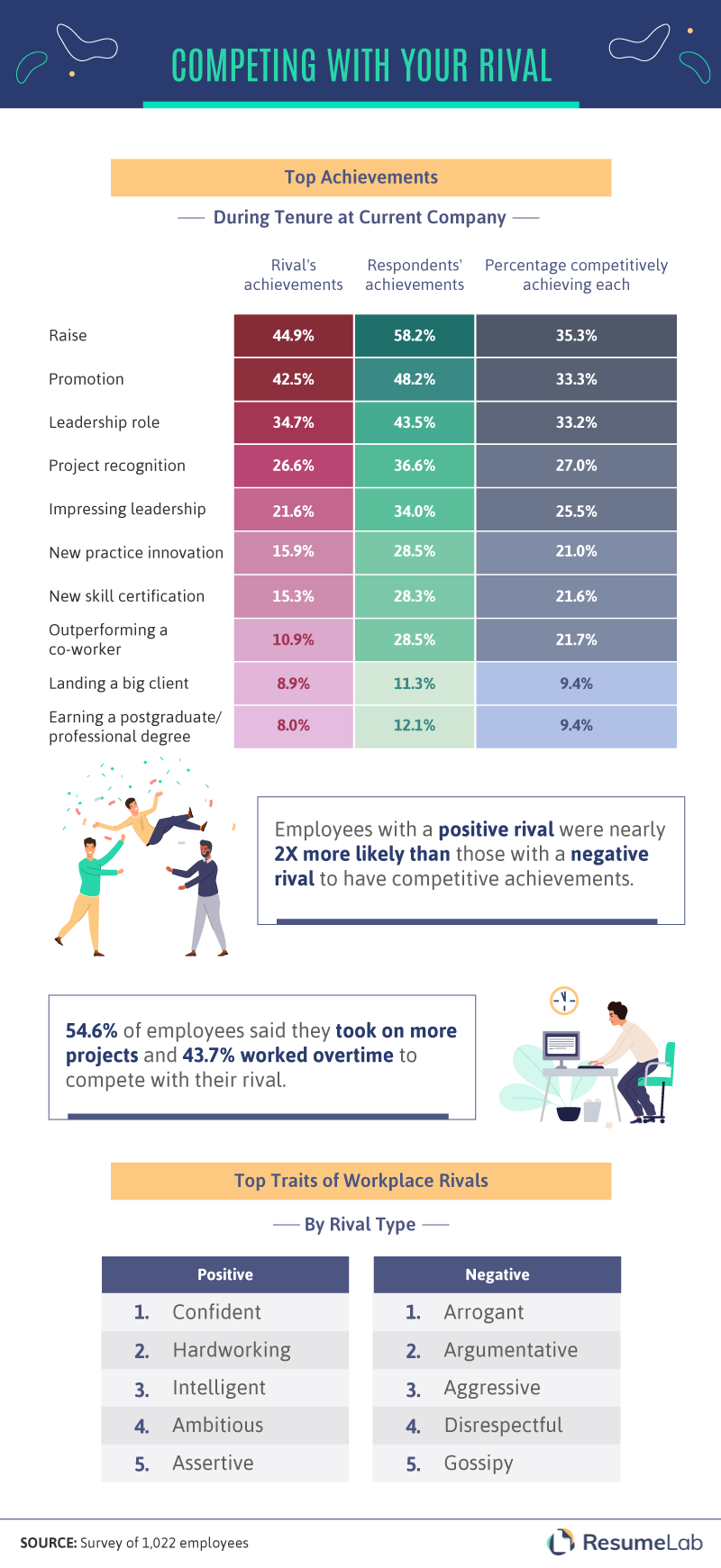
If you work a 40-hour workweek, you’ll spend roughly 2,000 hours every year with co-workers, managers, and office comrades (even with a vacation or two).
Understanding how to build meaningful relationships at work doesn’t just boost communication and productivity around the office; it can be crucial for feeling good about where you work and what you do. Of course, when it comes to the people you work with, healthy competition can be just as important for building trust and fostering open dialogue as anything else.
So, how often do rivalries at work take a more positive turn? To find out, we surveyed over 1,000 people to understand how many see workplace competition as a positive, how companies can promote constructive rivalries, and the overall impact controlled conflicts can have on productivity and other accomplishments. Read on to see what we uncovered.
Competition Status Quo

Experts say workplace rivalries can help motivate and inspire employees to work harder. However, competition can spiral out of control, creating a hostile and negative work environment.
More than 4 in 5 employees said they competed with a co-worker. Nearly 70% identified the competition as healthy, but the remainder said it was unhealthy and motivated by self-interest.
In most cases, men and women stuck to their own gender when it came to their workplace rivals (either positive or negative). Roughly 84% of women with a positive rivalry at work indicated their competition was with another woman, while around 87% of men said their competition was with another man. While women were equally likely to say their negative rivalries were also with women, nearly 1 in 3 men identified having a negative rivalry with a woman instead.
Similarly, most employees limited their in-office competitions to people with the same job level. More than 70% of entry-level, intermediate, and middle-management employees stuck to rivals in the same position, but more than 1 in 3 senior managers indicated their rivalry was with someone in a middle-management position instead.
Building a Better Work Atmosphere

The difference between healthy and unhealthy workplace competition may depend on the effort companies put into fostering positive relationships between employees.
Employees reporting having positive rivalries at work were roughly 6 percentage points more likely to work for a company that gave honest performance feedback, followed by learning opportunities and rewards for top performers. Compared to 28% of people with negative competition in their office, 39% with positive rivalries indicated their company set realistic goals. The biggest gaps were found among employees who indicated their companies created a positive atmosphere, provided team bonding exercises, and had transparent communication with team members.
Roughly 1 in 5 employees with negative rivalries indicated their office did none of the positive reinforcements we asked about. In contrast, those with positive competition were more than twice as likely to indicate their companies created an environment that promotes healthy competition.
Cause and Effect

Positive competition between co-workers isn’t just good for building relationships or improving morale. Employees who reported having a positive rival at work were nearly twice as likely as those with a negative rival to receive a promotion.
When asked about their workplace productivity, 63% of employees with a positive rival indicated feeling more productive because of the competition, compared to 51% of those with negative rivalries.
Employees with positive rivalries were also more likely to be moderately or extremely satisfied with their job and reported higher salaries, on average. Compared to those with no rival ($44,500) and those with negative rivalries ($53,000), employees who had healthy competition earned over $57,000 a year, on average. Around 60% of those with positive rivalries also indicated being satisfied with their job.
Competitive Achievements

Having healthy competition can also help you achieve personal and professional goals. Employees with a positive rival were nearly twice as likely as those with a negative rival to reach an achievement. During their tenure at their current company, 58% of employees with competition reported receiving a raise, followed by those who earned a promotion (48%), a leadership role (almost 44%), and recognition for a project (about 37%).
Having someone to challenge them was a compelling motivator for many employees. More than half indicated they took on more projects to compete with their rival, and almost 44% admitted to working overtime. Among those with positive rivals, competitors were identified primarily as confident, hardworking, and intelligent. Employees with negative rivalries described their competitors as predominantly arrogant, argumentative, and aggressive.
Finding a Healthy Work Environment
Healthy workplace competition can motivate you to take on tasks that lead to promotions, raises, and new opportunities. Not every rivalry is healthy, though, and negative competition around the office can leave you feeling worse about your job and the people you work with. The difference between a healthy rivalry and unhealthy competition may come down to your work environment and how far your company goes to promote better team building and communication.
At ResumeLab, we know how important the right job and workplace environment can be to your personal growth and development. In just three easy steps, our state-of-the-art technology will help you craft the perfect resume, CV, or cover letter to make sure your application gets noticed. With expertly crafted templates, our resume tools can help boost your chances of getting hired at your dream job. Start building your resume today at ResumeLab.com.
Methodology and Limitations
To collect the data shown above, we conducted a survey of 1,022 respondents who were employed full or part time. Respondents were asked if they felt there were people in their office who they were competitive with, with 842 respondents answering yes, and 180 answering no. Respondents were asked to answer the survey while thinking of the co-worker they were most competitive with. A definition of healthy competition was used to define “positive rivals,” and a definition of unhealthy competition was used to define “negative rivals.”
Of the 842 respondents with competition, 586 identified their co-worker as a positive rival, and 256 identified their co-worker as a negative rival. The 180 respondents who reported no competition were identified as having no rivals. The respondent pool was 53.5% male, 46.3% female, and less than 1% nonbinary.
The data were calculated to exclude outliers. We did this by finding initial averages and standard deviations for the data. Then, the standard deviation was multiplied by three and added to the initial average. Any data point above the calculated number was then excluded from the data.
Because the survey relies on self-reporting, issues such as telescoping and exaggeration can influence responses. An attention-check question was included in the survey to make sure respondents did not randomly answer.
Fair Use Statement
Sharing the findings of this study doesn’t have to be a competition. If your readers are interested in learning more about healthy rivalries at work, feel free to utilize the findings and graphics in this report for any noncommercial use with a link back to this page as a credit to our team of contributors.
About Us
We aim to help you find a healthy work environment. We provide you with the knowledge on how to write a cover letter or what's the best resume layout, and with the tools required to make a perfect job application. Our resume builder & cover letter generator will help you to make a job-winning application in no time.


![Positive Rivals at Work [2020 Study]](https://cdn-images.resumelab.com/pages/positive_rivals_at_work_hero.jpg)






![A Boss From Hell [2020 Study]](https://cdn-images.resumelab.com/pages/bad_boss_listing.jpg)
![From BFF to Your Boss [2020 Study]](https://cdn-images.resumelab.com/pages/from_friend_to_boss_listing.jpg)